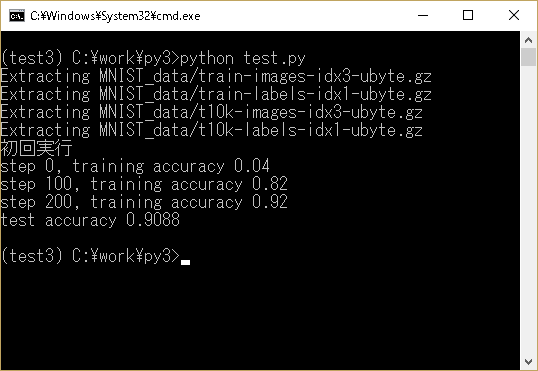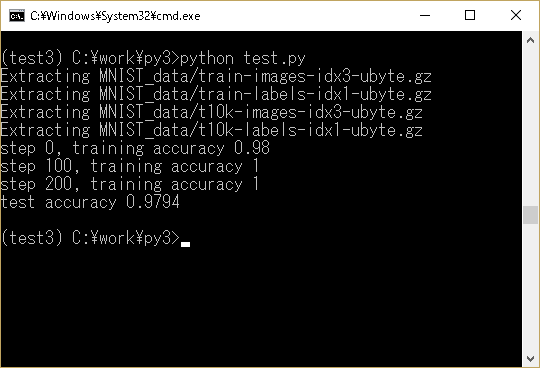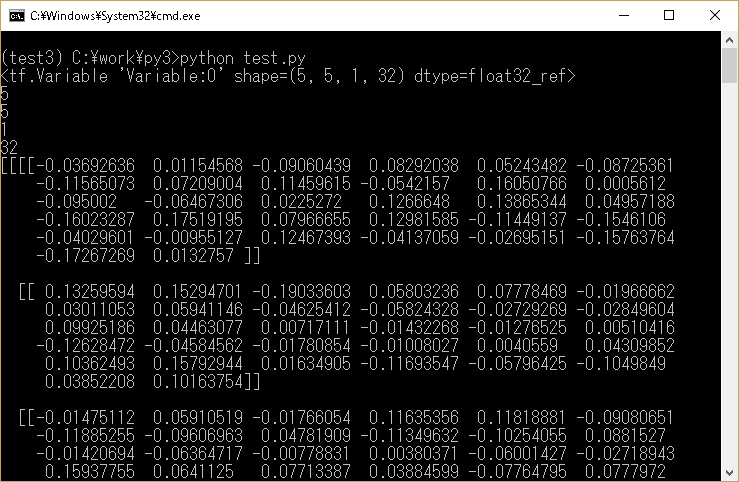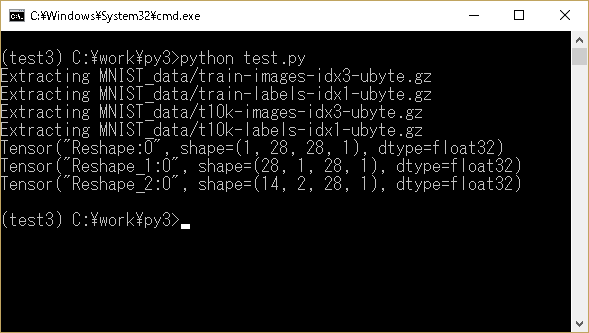TensorFlow MNIST2
今回は前回の文字認識を少し難しい処理でやってみます。チュートリアルのサンプル(少し編集)
import tensorflow as tf
from tensorflow.examples.tutorials.mnist import input_data
import os
def weight_variable(shape):
initial = tf.truncated_normal(shape, stddev=0.1)
return tf.Variable(initial)
def bias_variable(shape):
initial = tf.constant(0.1, shape=shape)
return tf.Variable(initial)
def conv2d(x, W):
return tf.nn.conv2d(x, W, strides=[1, 1, 1, 1], padding='SAME')
def max_pool_2x2(x):
return tf.nn.max_pool(x, ksize=[1, 2, 2, 1],
strides=[1, 2, 2, 1], padding='SAME')
os.environ['TF_CPP_MIN_LOG_LEVEL'] = '2'
mnist = input_data.read_data_sets("MNIST_data/", one_hot=True)
x = tf.placeholder(tf.float32, [None, 784])
y_ = tf.placeholder(tf.float32, [None, 10])
W_fc1 = weight_variable([7 * 7 * 64, 1024])
b_fc1 = bias_variable([1024])
W_conv1 = weight_variable([5, 5, 1, 32])
b_conv1 = bias_variable([32])
W_conv2 = weight_variable([5, 5, 32, 64])
b_conv2 = bias_variable([64])
x_image = tf.reshape(x, [-1, 28, 28, 1])
h_conv1 = tf.nn.relu(conv2d(x_image, W_conv1) + b_conv1)
h_pool1 = max_pool_2x2(h_conv1)
h_conv2 = tf.nn.relu(conv2d(h_pool1, W_conv2) + b_conv2)
h_pool2 = max_pool_2x2(h_conv2)
h_pool2_flat = tf.reshape(h_pool2, [-1, 7 * 7 * 64])
h_fc1 = tf.nn.relu(tf.matmul(h_pool2_flat, W_fc1) + b_fc1)
keep_prob = tf.placeholder(tf.float32)
h_fc1_drop = tf.nn.dropout(h_fc1, keep_prob)
W_fc2 = weight_variable([1024, 10])
b_fc2 = bias_variable([10])
y_conv = tf.matmul(h_fc1_drop, W_fc2) + b_fc2
cross_entropy = tf.reduce_mean(
tf.nn.softmax_cross_entropy_with_logits(labels=y_, logits=y_conv))
train_step = tf.train.AdamOptimizer(1e-4).minimize(cross_entropy)
correct_prediction = tf.equal(tf.argmax(y_conv, 1), tf.argmax(y_, 1))
accuracy = tf.reduce_mean(tf.cast(correct_prediction, tf.float32))
# saverを作成
saver = tf.train.Saver()
with tf.Session() as sess:
sess.run(tf.global_variables_initializer())
# 保存データ確認
if tf.train.get_checkpoint_state('.'):
try:
# 保存データ読み込み
saver.restore(sess, "./test2")
except:
print("保存と読み込みでsave_pathが異なる?")
else:
print("初回実行")
# 処理に時間が掛かるため
# for i in range(20000):
for i in range(201):
batch = mnist.train.next_batch(50)
if i % 100 == 0:
train_accuracy = accuracy.eval(feed_dict={
x: batch[0], y_: batch[1], keep_prob: 1.0})
print('step %d, training accuracy %g' % (i, train_accuracy))
train_step.run(feed_dict={x: batch[0], y_: batch[1], keep_prob: 0.5})
print('test accuracy %g' % accuracy.eval(feed_dict={
x: mnist.test.images, y_: mnist.test.labels, keep_prob: 1.0}))
# データ保存
saver.save(sess, './test2')
イメージ(初回)

イメージ(数回実施後)

tf.truncated_normal
tf.truncated_normalは乱数(切断正規分布)を生成します。
import tensorflow as tf
from tensorflow.examples.tutorials.mnist import input_data
import os
def weight_variable(shape):
initial = tf.truncated_normal(shape, stddev=0.1)
return tf.Variable(initial)
os.environ['TF_CPP_MIN_LOG_LEVEL'] = '2'
W_conv1 = weight_variable([5, 5, 1, 32])
with tf.Session() as sess:
sess.run(tf.global_variables_initializer())
ary = sess.run(W_conv1)
print(W_conv1)
print(len(ary))
print(len(ary[0]))
print(len(ary[0][0]))
print(len(ary[0][0][0]))
print(ary)
イメージ

tf.reshape
tf.reshapeは指定した形に変換します。-1を指定すると自動的に形を判断してくれます。
import tensorflow as tf
from tensorflow.examples.tutorials.mnist import input_data
import os
def weight_variable(shape):
initial = tf.truncated_normal(shape, stddev=0.1)
return tf.Variable(initial)
os.environ['TF_CPP_MIN_LOG_LEVEL'] = '2'
mnist = input_data.read_data_sets("MNIST_data/", one_hot=True)
batch_xs, batch_ys = mnist.train.next_batch(100)
print(tf.reshape(batch_xs[0], [-1, 28, 28, 1]))
print(tf.reshape(batch_xs[0], [-1, 1, 28, 1]))
print(tf.reshape(batch_xs[0], [-1, 2, 28, 1]))
イメージ

ページのトップへ戻る